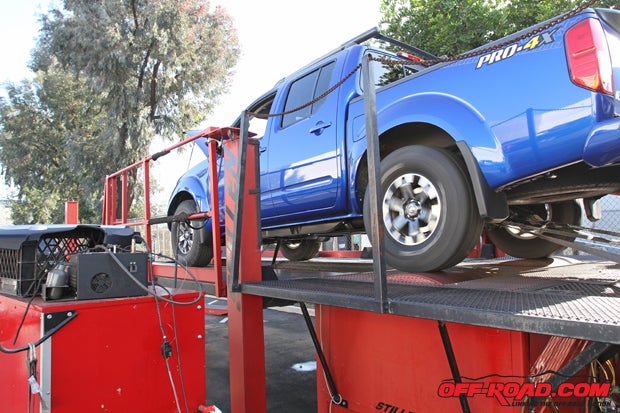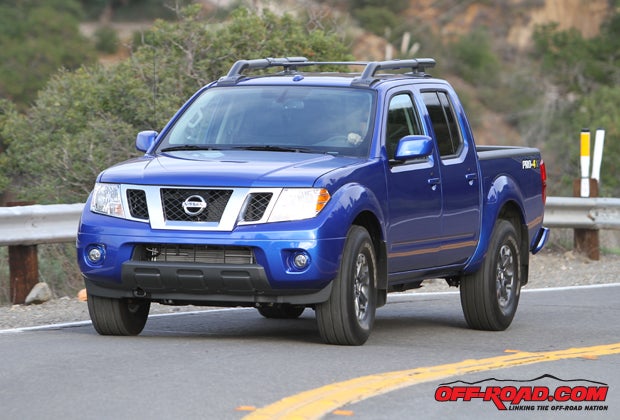2015 Mid-Size Truck Shootout: Colorado vs. Tacoma vs. Frontier + Video
2015 Mid-Size Truck Shootout
Which V-6 Packs the Best Punch?
Middleweight MMA fighters aren�t typically known for brute force, and the same holds true for mid-size trucks, aside from the now defunct Dodge Dakota and previous generation Colorado, which were both offered with V8 power as an option. For one reason or another, mid-size truck buyers never moved up to the larger �light heavyweight� half-tons where V8s were more readily available. Instead, the current half-ton crop is powered by V6s in search of all-important fuel economy while still delivering enough torque and horsepower for medium-duty demands.

As the new kid on the block, Chevy tried to improve key areas which were in need of attention in this segment � namely horsepower and fuel economy. To that end, the Colorado comes with a new 3.6-liter V6 which uses dual overhead cams, variable valve timing and direct-injection to produce a class-leading 305 horsepower. It also produces 269 lb.-ft. of torque and offers an impressive 7,000 pound maximum tow rating. It is the only motor mated to a six-speed transmission in this test.
What may be most head turning for consumers is the Chevy�s fuel economy, with the V6 earning a 26 mpg 2WD highway rating (24 mpg for our 4x4 test truck). Overall, the new Colorado has a combined EPA rating of 21 mpg for 2WD models (18 city, 26 hwy) and 20 mpg for 4x4 models (17 city, 24 hwy). During testing, our measured combined cycle fuel consumption was 20.5 mpg, which was actually a bit higher than the 19.6 mpg reading indicated by our test truck�s instrumentation.
PUNCHING POWER
Toyota Tacoma 4.0L V6 (5-speed auto, 6-speed manual)
236 hp @ 5200 rpm
266 ft.-lb. @ 4000 rpm
Nissan Frontier 4.0L V6 (5-speed auto, 6-speed manual)
261 hp @ 5600 rpm
281 ft.-lb. @ 4000 rpm
Chevrolet Colorado 3.6L V6 (6-speed auto)
305 hp @ 6800 rpm
269 ft.-lb. @ 4300 rpm

The Toyota Tacoma�s motor has remained relatively unchanged throughout its 10-year lifespan, but as the best-selling truck in this class for every-single-year of that decade, the lack of updates haven�t seemed to hurt its sales. The Tacoma produces 236 hp and 266 ft.-lb. of torque from its variable valve timing equipped 4.0-liter V6. Although TRD doesn�t provide performance data for the upgraded exhaust that comes standard with the T/X Baja Series trim package, we know there�s a very slight uptick for these figures when compared to the stock Tacoma exhaust. This engine is mated to a five-speed automatic transmission, and our Tacoma is rated for a maximum towing capacity of 6,500 pounds. Our 4x4 Double Cab model is EPA rated at 18 mpg combined (16 city, 21 hwy), and our observed fuel economy during testing was very close to that figure at 17.5 mpg combined.

Much like the Toyota, the Nissan Frontier hasn�t seen any significant powertrain updates since it was first introduced back in 2004. The Frontier is powered by a 4.0-liter DOHC V6 engine backed by a five-speed automatic transmission. It produces 261 horsepower and class-leading 281 lb.-ft. of torque. Nissan rates the Crew Cab Frontier Pro-4X we tested with a 6,100-pound maximum tow rating. While the Frontier�s engine�s output is very competitive, it�s the least fuel efficient motor of this bunch according to EPA ratings, at 17 mpg (15 city/21 hwy). During testing, our observed fuel economy numbers fell even shorter than that, with the Nissan recording 15.4 miles per gallon.
To obtain objective performance numbers, we gathered 0-60 and ¼-mile times for each truck. We also headed over to a local tuning shop for dyno testing on the last day of the shootout, but their dyno went down and required unforeseen maintenance which couldn�t be completed before we had to return our test trucks, an unfortunate fact that forced us to rely on manufacturer-supplied ratings for this story. All was not lost though, as we were still able to conduct real-world acceleration trials with each truck subjected to multiple runs to achieve the quickest times possible. The Colorado was clearly the quickest, sprinting from 0-60 mph in just 7.85 seconds. The Frontier was second-quickest at 8.76 seconds to 60, closely followed by the Tacoma at 8.79 seconds.
An unforeseen maintenance issue at our test facility prevented us from gathering dynamometer data on each truck, but we did gather plenty of objective data to pair with our subjective opinions in order to reach a well-rounded decision on the trucks. 
GROUND AND POUND
Chevrolet Colorado
0-60: 7.85 sec.
1/4 Mile: 15.79. sec. @ 91.58 mph
Toyota Tacoma
0-60: 8.79 sec.
1/4 Mile: 16.77 @ 86.86
2015 Nissan Frontier
0-60: 8.76 sec.
1/4 Mile: 16.81 sec. @ 85.34 mph
In the 1/4-mile the Colorado was quickest and fastest by sizable margins, reaching the distance in 15.79 seconds with a trap speed of 91.58 mph. The Tacoma turned the tables on the Nissan in the ¼ mile, edging it out for second, with a time of 16.77 seconds at 86.86 mph, while the Frontier was just a smidge slower at 16.81 seconds and 85.34 mph.

The Chevrolet certainly earned the lion�s share of objective category wins, but our seat-of-the-pants feel for it didn�t fully reinforce its 3.6-liter V6�s perceived dominance. Tester Scott Rousseau noted that while the Colorado had quicker 0-60 times than the other two, �It really doesn�t feel as hearty as the other two right off the bottom. You really have to mash the Chevy�s loud pedal to keep its 6L50 6-speed transmission from a fuel-economy seeking up-shift.� But Rousseau still felt that -compared to the Tacoma and Frontier - �The Colorado�s engine feels like it can do the most work, but hitting its peak torque figure at 4000 rpm means that it also sounds like it is working harder than the other two.� Alexander praised the Colorado�s linear power delivery and hailed its engine as the most predictable of the bunch. Burns also liked the overall linear power delivery but noted its six-speed trans seemed to stifle bottom-end liveliness.

The Toyota sits at the bottom of the pile in both horsepower and torque ratings, but as tester Rousseau noted, �I was surprised to learn that the Tacoma makes less torque than the Colorado because it seems so much more eager to leap away from a stoplight.� Then again, that may have more to do with throttle mapping and transmission tuning; or it could be the fact that the Tacoma�s 4.0-liter V6 still has the edge in cubic-inch displacement and weight-to-torque ratio compared to the Colorado�s 3.6-liter V6. At the top-end, the Tacoma does tend to run out of steam earlier than the Chevy and Nissan, though. The Tacoma seems to have a bit more �roughneck character� to it compared to the others, as one tester put it, which may stem from the TRD cat-back exhaust on the T/X Baja package. Burns and Rousseau noted the annoying resonance of the exhaust when stepping on the gas, which can be somewhat mitigated by feathering the throttle at cruising speed. Tester Alexander, a man with an affinity and passion for roadracing and sportscars and who has owned more exotic sporting hardware than the other testers combined, was unfazed by the Tacoma�s relatively louder exhaust tone.
THE WEIGH IN*
Toyota Tacoma T/X Baja 4x4 � 4,400 lbs.
Chevrolet Colorado Z71Crew Cab 4x4 � 4,500 lbs.
Nissan Frontier PRO-4X 4x4 � 4,580 lbs.
*Trucks weighed with full tank of gas

The Nissan Frontier�s VQ series V6 certainly doesn�t feel like the most polished motor of the bunch, which may be most evident in its rough-edged tone and notably lower 15.4 mpg fuel economy. In some ways it feels like it gets lost in the shuffle. Its 4.0-liter powerplant performs acceptably and was near or better than the Tacoma in our acceleration testing, but it simply lacks character. The PRO-4X may have the most torque, but it just doesn�t have the same sporty feel as its competition, which as Rousseau noted may be due to it being the heaviest truck of the bunch at 4,580 lbs. We had no complaints about the Frontier�s five-speed transmission, which performed well regardless of driving conditions, but Rousseau pointed out, �It is interesting to note that Nissan has paired steeper internal transmission ratios than the Tacoma�s with a much taller differential ratio, 3.357:1.�


 Your Privacy Choices
Your Privacy Choices